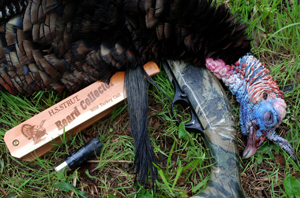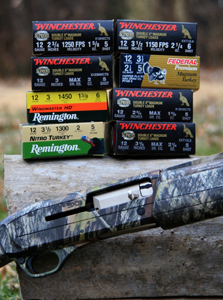
The early morning gobble startled me as I drifted off. I'd been up since 4 a.m. and daylight was slow to arrive. I had brought a complete arsenal of calls that I owned — store bought and custom turkey calls — and had them at the ready for when that big boss gobbler hit the ground. I was dressed in camouflage from head to toe; even my shotgun was camouflaged. Daylight overtook the darkness and the turkeys began opening up, gobbling all around me. The biggest problem I faced was deciding which one to shoot.
|
|
| Just because a shotgun will handle 3-1/2 inch shells doesn't mean they will pattern them well. Shoot every box of shells you can get your hands on to determine what load patterns the best. |
I hit my call and a big tom answered. He was just over a little rise to my left, as I readied myself into a comfortable shooting position he gobbled, and then double gobbled. This tom was hot. As he topped the hill, he looked as big as an ostrich and must have weighed 50 pounds. I laid my cheek on the shotgun — there it was again, doubt. A little voice murmured, "I hope I can get a pellet into his head." More negative thoughts raced through my mind. The bird hung up at 45 yards. Was the choke in my gun up to the task of putting more than 10 lethal pellets into the turkey's head at this range?
Suddenly, I jumped, hearing a ringing alarm clock; my wife shook me, letting me know I'd slept in. It was all a dream. I woke up drenched in sweat. I had time. I felt like Ebenezer Scrooge who had been given a second chance. I vowed I would not let this dream come true. That morning, in earnest, I began frantically gathering up boxes of shells. I had shells from every manufacturer in every shot size imaginable and in chamber sizes — 2 3/4, 3 and 3 1/2 inches — I was leaving no stone unturned.
This isn't your Daddy's turkey gun!
In the last 20 years, leaps and bounds have been made in the shotgun arena. Modern turkey hunters have more choices than ever: firearms, ammunition, chokes, stock configurations and camouflage patterns.
Taking stock in your shotgun
Twenty-five years ago, gunstocks were made of walnut. Today, most shotguns used by turkey hunters are made of a synthetic composition. These stocks are not affected by moisture. They are lightweight and usually less expensive, although manufacturers are incorporating features into the synthetic stocks to aid in the reduction of recoil, which in turn raises the price tag. Stocks come in many different styles such as Monte Carlo, thumbhole and even collapsible stocks.
The 3-1/2 inch chamber
The 3-1/2 inch chamber is one of the most popular options in recent history. Waterfowlers discovered that the new steel pellets weren't as effective downing waterfowl, therefore creating the need to use bigger pellets to make up for the lack of lead density. Bigger pellets took up more space in the shell, so ammo makers began working to develop a new 12-gauge shell that would hold more of the bigger pellets. Voilà! The 3-1/2 inch chamber was born. Firearms manufacturers quickly noticed the demand and acted accordingly, increasing the length of the standard shotgun chamber to accommodate a new longer shell that held a giant payload. Who else wanted a lot of pellets? Turkey hunters. The more pellets downrange, the better the chance of putting more into a turkey's head.
 |
| Tools of the trade for serous turkey hunters: A Winchester SX2 with a Bushnell Holosight mounted atop. |
Initially, the introduction of the 3-1/2 inch chamber was not warmly embraced. Even with open chokes, the first guns patterned horribly. Manufacturers began testing and found that back-bored barrels were the answer to the problems that plagued the 3-1/2 inch guns. True back boring, increasing the diameter of the bore, by either polishing or using a special reamer or a combination of both, has many advantages over a standard bore. Back boring alleviates excess pressure caused by the larger charges of powder in the longer cartridge and reduces perceived felt recoil. Back-bored barrels also produce higher velocities and less deformed pellets than standard barrels, due to less barrel wall constriction creating less friction. Today, most firearms are not back bored, but over bored, the dimension of the bore made larger than the standard .729 of an inch to a nominal .740 of an inch, the Sporting Arms and Ammunition Manufacturers' Institute (SAAMI) standard. If your favorite shotgun isn't performing as well as you had hoped, there are many gunsmiths who specialize in back boring your current barrel. Aftermarket barrels are also available for many of today's shotguns.
Don't get choked up!
If you are serious about putting a lot of pellets in a turkey's head at 40 yards, a custom choke tube may be the answer. Choke tubes make the magic of a great pattern happen, but not solely. Choke restriction is important, but just as important is matching the choke constriction with the bore diameter of your barrel and the specific load you are shooting. This can only be achieved by the slow and painful process of patterning your shotgun. Major manufacturers mass produce chokes that fit the general populous, a one size fits all -- perhaps good enough for the occasional hunter, but seasoned turkey hunters demand the most from their equipment.
Now you see it, now you don't
The most obvious element of a turkey hunter's shotgun is the camouflage. In years past, I have seen spray paint -- which can do a decent job if time and care is given; and camouflage tape -- which can leave a sticky residue and a mess on your gun. However, nothing compares to the new finishes on modern shotguns. New shotguns are dipped in a film to accurately reproduce your favorite camouflage pattern. Nearly every firearm manufacturer has a camouflage model shotgun to hide your gun from the eyes of an old wary tom. If your shotgun is not camouflaged there are several firms that specialize in aftermarket camouflage. Any camouflage pattern imaginable can be put on your shotgun or any hunting gear.
Feed that shotgun what it likes
 |
| Patterning and having confidence in your turkey gun can reap rewards in a big way. |
Ammunition has changed dramatically and so quickly that last spring I inquired about a new ammunition offering, the sporting goods clerk gave me a puzzled look and asked, "What is that?" The newest kid on the block is tungsten-based shot, an alternative to lead that is 13 percent denser than lead. Tungsten shot is not actually new — waterfowlers have known for many seasons how effective tungsten can be on ducks and geese. Now turkey hunters have taken notice of the new lead alternative and most of the ammunition manufacturers have made finding the tungsten-based shot much easier.
Don't lose sight
Topping everything off, the addition of firearm sights — primarily rifle sights that glow in low-light conditions when a big gobbler is likely to show up -- are quite common on today's firearms. Many shotguns are drilled and tapped, as well, to accept scopes and other electronic sighting systems. Several optic manufacturers such as Leupold, Nikon and Bushnell have developed gun scopes designed exclusively for turkey hunters. Red dot scopes and reflex type sights like the Bushnell Holosight is gaining ground and has a large following amongst turkey hunters.
No magic potions
New technology won't replace legwork to locate a turkey; nor will it bring in a big tom from a mile away. Once you do your part, the last thing on your mind should be the question, "Can my gun do the job?" Today's offerings, or even your old standby tricked out with modern technology, will put your mind at ease and let you focus on bagging a big boss gobbler.
- 8544 views


